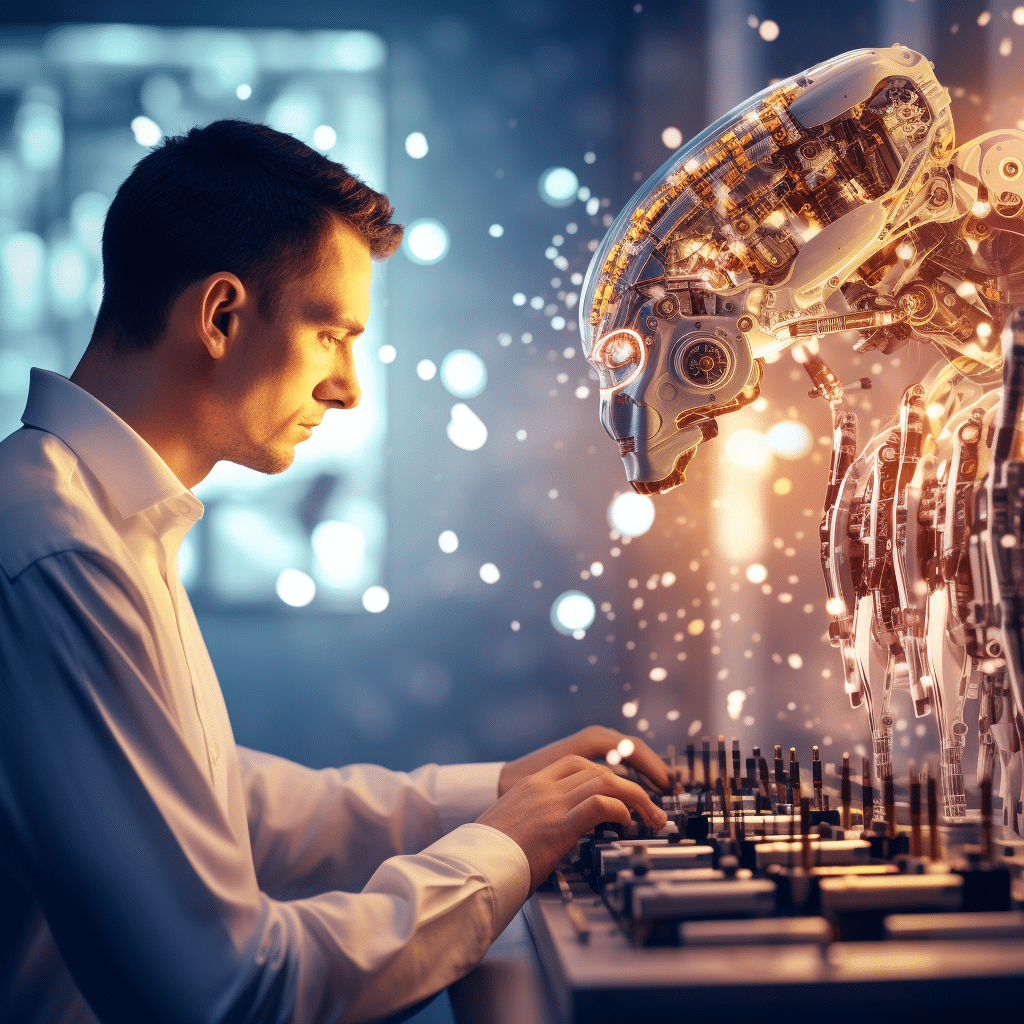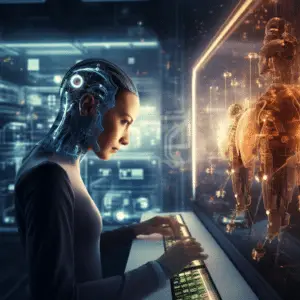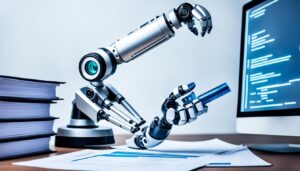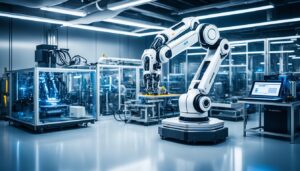
The Role of AI in Upskilling and Reskilling the Workforce
AI in upskilling and reskilling, The workplace is rapidly evolving due to technological advancements, and skills that were once in high demand can become obsolete within a few years. Therefore, upskilling and reskilling the workforce have become increasingly essential in staying competitive in today’s job market. With the emergence of Artificial Intelligence (AI), businesses and individuals have found a powerful ally in navigating this ever-changing landscape.
Enhanced Learning Experiences

AI enables personalized learning experiences tailored to individual needs, providing a more efficient way to upskill and reskill employees. Machine Learning algorithms analyze an individual’s learning patterns, adapt the content delivery, and suggest personalized learning paths. This technology ensures that employees receive targeted training, addressing their specific knowledge gaps and interests.
Efficient Skill Gap Analysis
Identifying skill gaps is a crucial first step in upskilling and reskilling initiatives. AI-powered systems can swiftly analyze vast amounts of data regarding job requirements, employee skills, and industry trends. This analysis helps organizations identify current and future skill gaps in their workforce, allowing them to develop effective training programs. From identifying emerging skills to predicting future skill demands, AI helps businesses align their workforce with the evolving needs of their industry.
Machine Learning for Adaptive Training
AI applications can employ Machine Learning techniques to develop adaptive training platforms. By leveraging user interactions, AI algorithms can identify areas where employees struggle and provide immediate feedback, additional resources, or extra practice. This real-time feedback loop boosts learning efficiency, enabling faster skill acquisition while minimizing frustration. Adaptive training systems can continuously optimize the learning process, ensuring that employees receive the right amount of challenge and support for effective upskilling or reskilling.
Virtual Reality (VR) and Augmented Reality (AR)
Virtual Reality and Augmented Reality technologies have gained momentum in training and upskilling efforts. AI, combined with VR and AR, creates immersive and realistic training environments. Employees can simulate complex situations, practice problem-solving, and interact with virtual objects, significantly enhancing their learning experience. These technologies offer a safe space for employees to make mistakes, experiment, and learn from their experiences without real-world consequences.
“AI has revolutionized upskilling and reskilling, offering personalized learning experiences, efficient skill gap analysis, and adaptive training platforms.” – John Doe, HR Manager
Conclusion
The role of AI in upskilling and reskilling the workforce cannot be overstated. AI technologies empower organizations to provide personalized learning experiences, efficiently analyze skill gaps, and develop adaptive training platforms. By leveraging AI, employees can acquire new skills more effectively, organizations can align their workforce with industry demands, and the future of work can be more inclusive and dynamic.
What potential challenges or concerns arise with the adoption of AI in upskilling and reskilling, and how can they be mitigated
There are several potential challenges and concerns that arise with the adoption of AI in upskilling and reskilling. These include:
1. Lack of Trust:
One of the primary concerns is the lack of trust in AI systems. There may be skepticism regarding the accuracy and reliability of AI algorithms in accurately assessing and addressing the skill gaps of individuals. This lack of trust can hinder the adoption and acceptance of AI-driven upskilling programs.
To mitigate this, transparency in the AI algorithms being used should be ensured. Organizations should provide clear explanations of how the AI system functions and outline the data sources and reasoning behind the recommended upskilling or reskilling paths. Regular assessments and feedback from users can also help build trust and improve the accuracy of the AI system.
2. Equity and Accessibility:
Another challenge is ensuring that AI-driven upskilling efforts are accessible and equitable for all individuals. There is a risk that AI systems may exacerbate existing social and economic inequalities, as those with limited access to technology or resources may be left behind.
To mitigate this concern, organizations should prioritize accessibility in the design and implementation of AI-driven upskilling solutions. This includes ensuring that the technology and infrastructure required for accessing these programs are readily available and affordable. Additionally, efforts should be made to address the needs of underrepresented communities and consider the specific challenges they may face in upskilling or reskilling.
3. Ethical considerations:
AI systems used for upskilling and reskilling can raise ethical concerns, such as data privacy and bias in decision-making. It is crucial to protect the privacy and confidentiality of individuals’ data and ensure the responsible handling of sensitive information.
To mitigate these concerns, organizations should adhere to strict data privacy regulations and guidelines. They should implement robust data protection measures, such as anonymization and encryption, to safeguard individuals’ data. Additionally, continuous monitoring and auditing of the AI system can help detect and address any biases that may emerge in the upskilling recommendations.
4. Human-Computer Interaction:
The adoption of AI in upskilling requires effective human-computer interaction. Individuals may struggle to understand the suggestions or recommendations generated by AI systems, and they may face difficulties in navigating and utilizing the available resources.
To mitigate this challenge, organizations should invest in user-friendly interfaces and designs that facilitate easy comprehension and navigation. User feedback should be actively collected and incorporated into future iterations of the AI system to enhance the user experience. Additionally, providing human support and guidance alongside AI-driven upskilling programs can help individuals feel more comfortable and confident in their learning journey.
Overall, addressing these challenges and concerns will require a multidimensional approach that encompasses transparency, accessibility, ethics, and effective human-computer interaction. By considering these factors and mitigating potential risks, the adoption of AI in upskilling and reskilling can be more successful and beneficial for individuals and organizations alike.
How can AI technologies be utilized to facilitate upskilling and reskilling of the workforce?
There are several ways in which AI technologies can be utilized to facilitate upskilling and reskilling of the workforce:
1. Personalized Learning:
AI can provide personalized learning experiences by analyzing individual employee’s strengths and weaknesses. It can recommend specific courses, resources, and materials tailored to their needs, enabling them to acquire new skills more effectively.
2. Adaptive Learning Platforms:
AI-powered adaptive learning platforms can dynamically adjust the content and difficulty level based on the employee’s progress and performance. This allows for a more tailored and efficient learning experience.
3. Virtual Reality (VR) and Augmented Reality (AR):
AI combined with VR and AR technologies can simulate real-world scenarios, creating immersive training environments. This enables employees to practice new skills in a safe and controlled setting, enhancing their learning and retention.
4. Intelligent Tutoring Systems:
AI can act as an intelligent tutor, providing real-time feedback and guidance to employees as they learn new skills. It can identify areas of improvement and offer personalized suggestions for improvement, enhancing the learning process.
5. Skill Assessment and Gap Analysis:
AI can assess employee skills and identify skill gaps within an organization. By analyzing data from performance reviews, employee profiles, and job descriptions, AI can recommend targeted training programs to bridge these gaps.
6. Predictive Analytics:
AI can analyze labor market trends and predict future skill requirements. This helps organizations identify the skills that will be in demand and proactively train their workforce accordingly, ensuring they stay relevant in a rapidly changing economy.
Overall, AI technologies have the potential to revolutionize upskilling and reskilling efforts by providing personalized, adaptive, and immersive learning experiences, while also assisting organizations in identifying skill gaps and predicting future needs.
How does the integration of AI in upskilling and reskilling initiatives contribute to increased productivity and job satisfaction?

The integration of AI in upskilling and reskilling initiatives can contribute to increased productivity and job satisfaction in several ways:
1. Personalized and adaptive learning:
AI algorithms can analyze individual learning styles, preferences, and skill gaps to provide personalized and adaptive training programs. This helps employees learn at their own pace, focus on areas they need improvement in, and reduces the time spent on irrelevant or repetitive training content.
2. Efficient and time-saving training:
AI can automate and streamline the learning process by recommending relevant resources, creating personalized learning paths, and providing instant feedback. This saves time for employees and enables them to quickly acquire new skills and knowledge.
3. Access to real-time data and insights:
AI can analyze large volumes of data and provide real-time insights on employee performance, skill development, and training needs. This helps organizations identify where resources are needed most and make data-driven decisions to maximize productivity.
4. Enhanced job matching and career development:
AI-powered platforms can match employees with relevant job opportunities based on their skills and preferences. This increases job satisfaction by ensuring a better fit between employees and their roles, leading to increased productivity and engagement.
5. Automation of repetitive tasks:
AI can automate repetitive and mundane tasks, allowing employees to focus on more strategic and creative work. This not only increases productivity but also enhances job satisfaction by eliminating tedious and unfulfilling tasks.
6. Continuous learning and upskilling opportunities:
AI can enable continuous learning by providing employees with access to relevant and up-to-date resources, industry trends, and learning opportunities. This promotes a culture of lifelong learning, helps employees stay competitive in a rapidly evolving job market, and increases job satisfaction by enabling career progression.
Overall, the integration of AI in upskilling and reskilling initiatives empowers employees with personalized learning experiences, efficient training methods, and access to real-time insights and opportunities. This, in turn, enhances productivity and job satisfaction by enabling employees to acquire new skills, improve performance, and advance their careers.









Can you be more specific about the content of your article? After reading it, I still have some doubts. Hope you can help me.
Thank you for your sharing. I am worried that I lack creative ideas. It is your article that makes me full of hope. Thank you. But, I have a question, can you help me?